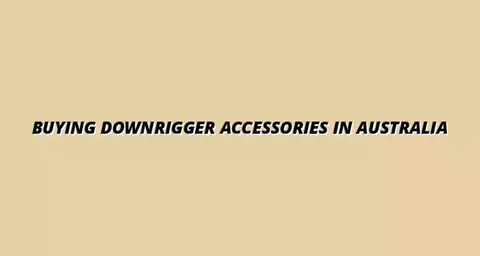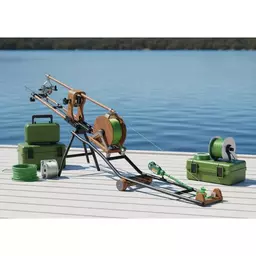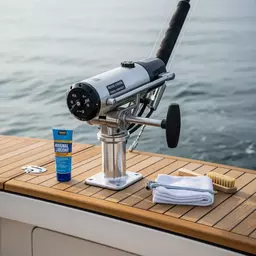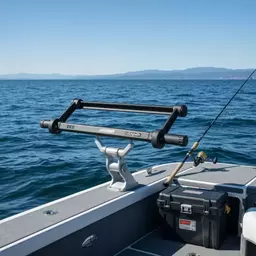Did you know that regular maintenance of your downrigger can significantly enhance your fishing success? By ensuring your gear is in top condition, you're not only safeguarding your investment but also elevating your overall fishing experience. Let's explore some essential insights that every Australian angler should be aware of!
What You Will Learn
- Routine maintenance prevents rust and corrosion on key components, ensuring your downrigger performs reliably.
- Understanding Australia's unique environmental challenges helps protect your equipment from saltwater and UV exposure.
- Regular checks can identify potential issues early, saving you from costly repairs and unexpected breakdowns.
- Implementing effective maintenance strategies enhances the longevity of your gear and improves your fishing success.
Downrigger Maintenance: Practices & Impact
Understanding the key aspects of downrigger maintenance, from routine checks to addressing environmental factors, ensures longevity and optimal performance of your equipment.
Routine Checks & Longevity
Regular inspections prevent unexpected issues, improve safety, and extend your downrigger's lifespan by identifying wear early.
- • Cable for fraying
- • Spool for smooth operation
- • Electrical connections
Australian Conditions & Durability
Unique climate factors like saltwater, UV, and temperature swings demand specific protective measures.
- ● Rinse after saltwater use
- ● Store away from direct sun
- ● Check for heat damage
Understanding the Importance of Downrigger Maintenance for Australian Anglers
As a passionate angler, I can't emphasize enough the significance of keeping your downrigger in top condition. Regular maintenance is not just about prolonging the life of your equipment—it's about ensuring a successful and enjoyable fishing experience on Australia's diverse waters. By taking the time to maintain your downrigger, you're investing in both your gear and your fishing adventures!
When you think about it, our beloved fishing gear faces numerous challenges—from saltwater corrosion to harsh sun exposure. This is why I always advocate for a routine maintenance schedule. It might seem like a hassle at first, but it can save you from unexpected breakdowns and costly repairs down the line. Let's dive into why regular maintenance should be a priority for every Australian angler.
Why Regular Maintenance Matters for Prolonging Equipment Life
- Prevents rust and corrosion on crucial components
- Ensures reliable performance during trips
- Identifies potential issues before they escalate
- Enhances the longevity of your investment
Implementing these maintenance practices not only enhances your downrigger's functionality but also contributes to a smoother fishing experience. I know from personal experience that there's nothing more frustrating than dealing with equipment failure when you're out on the water. Regular checks can help avoid those moments and keep your fishing trips enjoyable! For more detailed instructions on maintaining your downrigger, including specific repairs, you can refer to resources like Island Fisherman Magazine's DIY downrigger repairs guide.
So, as you prepare for your next fishing adventure, take a moment to reflect on the importance of maintaining your downrigger. A little effort goes a long way in ensuring that your fishing gear is ready for whatever the Australian seas throw your way.
How Australian Conditions Affect Downrigger Durability
Australia's unique climate can be both a friend and a foe to our fishing equipment. The combination of saltwater, UV exposure, and fluctuating temperatures can lead to quicker wear and tear. That’s why understanding these factors is crucial for every angler!
- Saltwater Exposure: It’s notorious for causing corrosion, so rinsing your downrigger after each use is essential.
- Sunlight: UV rays can degrade plastics and rubber components, so storing your gear away from direct sunlight can help.
- Temperature Variations: Extreme heat can affect the integrity of your downrigger's components, making routine checks vital.
By being mindful of these conditions, you'll be better equipped to protect your downrigger from the elements. I’ve seen too many anglers overlook these factors, resulting in equipment failures that could have easily been avoided. It’s all about being proactive and ensuring your gear can withstand the beautiful yet demanding Australian environment! For additional tips on maintaining your downrigger in various conditions, consider consulting Cannon's guide to downrigger maintenance.
Key Downrigger Maintenance Practices to Implement
Now that we've established why maintenance is key, let's explore some essential practices that can make a significant difference. By following these steps, you can enhance your downrigger's performance and ensure it's always ready for your next fishing trip.
Remember, a well-maintained downrigger means more time fishing and less time worrying about equipment issues. The goal here is to create a routine that works for you—so let’s roll up our sleeves and dive into the details!
We Want to Hear From You!
As you think about your downrigger maintenance routine, what challenges have you faced while keeping your gear in top shape? Share your thoughts below:
Frequently Asked Questions About Downrigger Maintenance
- Q: Why is regular downrigger maintenance so important for Australian anglers?
- A: Regular maintenance prolongs equipment life, ensures reliable performance, and helps identify issues early, which is crucial for tackling Australia's diverse fishing conditions and avoiding costly repairs.
- Q: What specific Australian environmental factors impact downrigger durability?
- A: Saltwater exposure causes corrosion, UV rays degrade plastics and rubber, and fluctuating temperatures can affect component integrity. Proactive measures are necessary to combat these factors.
- Q: What are the key maintenance practices I should implement for my downrigger?
- A: Essential practices include inspecting cables and connectors, cleaning your downrigger after each use (especially in saltwater), adjusting brakes, and lubricating moving parts.
- Q: How often should I perform routine checks on my downrigger?
- A: It's recommended to inspect your downrigger cable for fraying, check the spool mechanism, and examine electrical connections regularly, ideally after each significant use, to ensure optimal performance and safety.
- Q: How does preventive maintenance benefit my fishing success?
- A: Preventive maintenance prevents costly repairs, improves equipment reliability, increases the lifespan of your gear, and enhances your fishing success by ensuring your downrigger performs at its best, allowing you to focus on your techniques and enjoy the outdoors.
Summarizing Effective Downrigger Maintenance Strategies
As we wrap up our discussion on downrigger maintenance, it’s essential to recognize that implementing routine checks can significantly enhance your equipment's longevity. Regular maintenance not only prevents unexpected breakdowns but also ensures that your downrigger performs optimally when you need it most. Remember, a little time spent on maintenance today can save you from costly repairs tomorrow!
Adopting a systematic approach to maintenance will help you identify potential issues early. For instance, checking your cables regularly can prevent damage that could interfere with your fishing experience. Here are a few key maintenance practices to keep in mind:
- Inspect cables and connectors for signs of wear
- Clean your downrigger after each use, especially in saltwater
- Adjust brakes to match the conditions of your fishing environment
- Lubricate moving parts to ensure smooth operation
By incorporating these practices into your routine, you ensure that your downrigger stays in top shape for many successful fishing expeditions!
Routine Checks and Their Impact on Equipment Longevity
Performing routine checks offers numerous benefits that extend beyond just keeping your equipment functional. Regular inspections can help you understand the overall health of your downrigger, and this proactive approach means you're less likely to encounter unexpected issues while out on the water. As a fishing enthusiast, I can’t stress enough how critical it is to be familiar with your gear's requirements!
Here’s a quick checklist for your routine downrigger checks:
- Inspect the downrigger cable for fraying or kinks
- Examine the spool mechanism for smooth operation
- Check electrical connections if you have an electric downrigger
- Clean the ball weight and release mechanism regularly
Following this checklist will not only enhance performance but also improve safety while fishing. Trust me, you’ll appreciate the peace of mind that comes with knowing your equipment is in excellent condition!
Why Australian Anglers Should Invest in Preventive Maintenance
Preventive maintenance is an investment every Australian angler should make. It’s about much more than just keeping your downrigger functioning; it’s about enhancing your overall fishing experience. By taking proactive measures, you’re ensuring that your gear stands up to the unique challenges posed by our diverse Australian waters.
Consider this: investing time and resources into maintenance means less time worrying about equipment failures and more time focusing on your fishing techniques and enjoying the great outdoors. Here’s why it’s vital:
- Prevents costly repairs
- Improves equipment reliability
- Increases the lifespan of your gear
- Enhances your fishing success through better performance
In the end, the benefits of preventive maintenance are clear. It’s a small price to pay for the joy of reeling in that big catch while knowing your equipment is ready for action! For a broader perspective on responsible outdoor practices, including caring for your gear, you can explore resources such as the National Park Service's fishing guidelines, which emphasize ecological stewardship alongside equipment care.
Recap of Key Points
Here is a quick recap of the important points discussed in the article:
- Regular maintenance of downriggers is essential for prolonging equipment life and ensuring optimal performance.
- Saltwater corrosion, UV exposure, and temperature variations significantly impact downrigger durability, making proactive care necessary.
- Key maintenance practices include inspecting cables, cleaning after each use, adjusting brakes, and lubricating moving parts.
- Routine checks help identify potential issues early, enhancing safety and performance while fishing.
- Investing in preventive maintenance saves time and money, allowing anglers to focus on their fishing experience.







